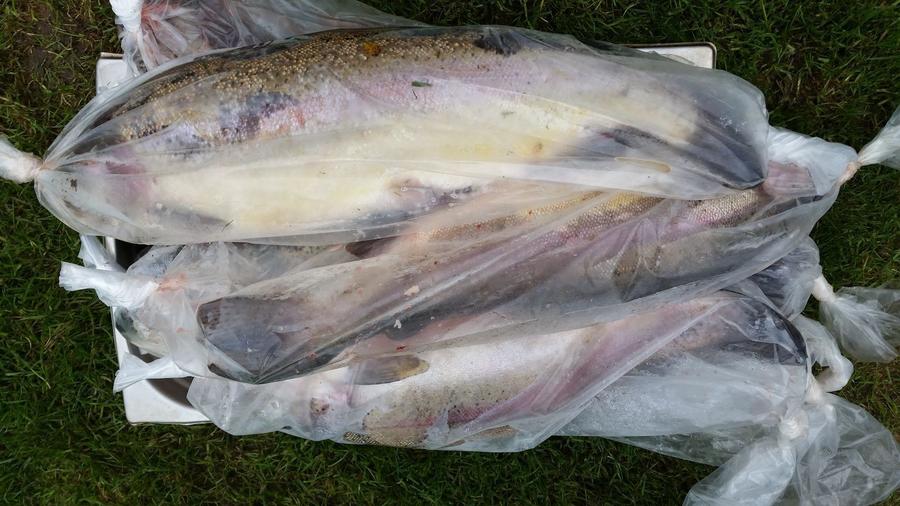During my visit to Forman's salmon smokery on London last week (http://www.smokingmeatforums.com/t/236394/smoked-salmon-slicing#post_1479725) - I managed to spend some time with Darren Matson and discussed in detail the various techniques they use for smoking their salmon. They specialise in producing a mild "London Cure" salmon and the end result is exceptional (well it has to be for them to supply the likes of Harrods and Fortnum & Masons) - however several of the steps they used were somewhat different to mine. In the continuous process of refining my own technique I decided to try to incorporate some of their methods with mine at home.
As it happens the Smoking Gods were with me and later Friday evening I got a call from one of my regular fisherman to ask if I could do something with the 10 large trout that he and a couple of friends had caught that day. This was an opportunity I could not refuse. He brought them round and they went in the fridge overnight.
The next morning I started to prepare them.
Variation 1. Whereas I would usually fillet and pinbone the fish before curing, they simply split the fish and removed the backbone. The fish is cured with the rib cage and other bones sill in.
Variation 2, They cut away a number of small patches of skin along the thickest part of the body to help the cure penetrate evenly through the fish
Variation 3. I usually cure my fish singly in the cure however they stack their fish up to 3 high. This saved a lot of space.
For the cure they use crystalised rock salt as they say the type of salt (rock or sea salt) makes little difference to the end result - and they do not use any sugar in their cure. Here I stuck to my own cure combination of 50% Dead Sea salt and 50% sugar. By stacking the fish as they do I only needed to use about 1/3 of the amount of cure that I would usually use when curing them individually.
They were left in the cure for 24 hours in the fridge before being thoroughly rinsed with cold running tap water to remove all remaining traces of the cure mixture. They were then patted dry with paper towel and stringed.
Variation 4. Usually I smoke my large fish horizontally as I found that they distorted under their own weight when hanging. They showed me how the addition of a simple skewer placed at the top of the fish supports the weight during the drying and smoking. In the photo below you can see that I have used Weber kebab skewers to achieve the same result - my new skewers are now on order though.
The fish were then smoked for 36 hours <<edit - I subsequently found that 24 hours is more than sufficient >>. Formans only smoke for 24 hours for their London Cure.
Variation 5. Whereas I usually smoke at a low temperature for longer, Formans smoke their salmon at 25-28 C (77-82 F) to help speed up the drying process. I set the smoker to 26 C (79 F) for the smoke.
<<Edit: I have subsequently found that a 24 hour smoke is sufficient to give the required water loss and smoke flavour>>
When I took them out of the smoker they looked and smelled very good. A great colour, nice firm oily flesh and the skewers had really helped them to keep their shape.
They were then put into the fridge overnight to rest.
Slicing next day was really straightforward. The rib cage was easy to remove, with no wasted flesh, and the pinbones came out easily too,
Variation 6. Where I would usually cure and smoke mine filleted I would leave the outer pellicle on when I slice. Formans always remove the pellicle before slicing - so I did too. The photo below was taken part way through the smoky pellicle being removed.
The pellicle trimmings are not wasted though. These they use in their smoked salmon pate.
I then sliced the trout using the traditional "D" cut.
Slip the knife along the skin and the slices are removed leaving no waste.
The slices were then weighed onto boards and vac packed.
We all often get used to doing things in the same way time after time. My trip to Formans though gave me some great ideas to tweak and improve my method - and I will now be incorporating these changes into my standard smoking technique.
As it happens the Smoking Gods were with me and later Friday evening I got a call from one of my regular fisherman to ask if I could do something with the 10 large trout that he and a couple of friends had caught that day. This was an opportunity I could not refuse. He brought them round and they went in the fridge overnight.
The next morning I started to prepare them.
Variation 1. Whereas I would usually fillet and pinbone the fish before curing, they simply split the fish and removed the backbone. The fish is cured with the rib cage and other bones sill in.
Variation 2, They cut away a number of small patches of skin along the thickest part of the body to help the cure penetrate evenly through the fish
Variation 3. I usually cure my fish singly in the cure however they stack their fish up to 3 high. This saved a lot of space.
For the cure they use crystalised rock salt as they say the type of salt (rock or sea salt) makes little difference to the end result - and they do not use any sugar in their cure. Here I stuck to my own cure combination of 50% Dead Sea salt and 50% sugar. By stacking the fish as they do I only needed to use about 1/3 of the amount of cure that I would usually use when curing them individually.
They were left in the cure for 24 hours in the fridge before being thoroughly rinsed with cold running tap water to remove all remaining traces of the cure mixture. They were then patted dry with paper towel and stringed.
Variation 4. Usually I smoke my large fish horizontally as I found that they distorted under their own weight when hanging. They showed me how the addition of a simple skewer placed at the top of the fish supports the weight during the drying and smoking. In the photo below you can see that I have used Weber kebab skewers to achieve the same result - my new skewers are now on order though.
The fish were then smoked for 36 hours <<edit - I subsequently found that 24 hours is more than sufficient >>. Formans only smoke for 24 hours for their London Cure.
Variation 5. Whereas I usually smoke at a low temperature for longer, Formans smoke their salmon at 25-28 C (77-82 F) to help speed up the drying process. I set the smoker to 26 C (79 F) for the smoke.
<<Edit: I have subsequently found that a 24 hour smoke is sufficient to give the required water loss and smoke flavour>>
When I took them out of the smoker they looked and smelled very good. A great colour, nice firm oily flesh and the skewers had really helped them to keep their shape.
They were then put into the fridge overnight to rest.
Slicing next day was really straightforward. The rib cage was easy to remove, with no wasted flesh, and the pinbones came out easily too,
Variation 6. Where I would usually cure and smoke mine filleted I would leave the outer pellicle on when I slice. Formans always remove the pellicle before slicing - so I did too. The photo below was taken part way through the smoky pellicle being removed.
The pellicle trimmings are not wasted though. These they use in their smoked salmon pate.
I then sliced the trout using the traditional "D" cut.
Slip the knife along the skin and the slices are removed leaving no waste.
The slices were then weighed onto boards and vac packed.
We all often get used to doing things in the same way time after time. My trip to Formans though gave me some great ideas to tweak and improve my method - and I will now be incorporating these changes into my standard smoking technique.
Last edited:


















